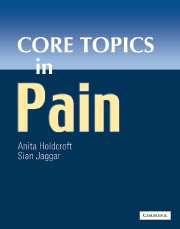Book contents
- Frontmatter
- Contents
- Contributors
- Preface
- Acknowledgements
- Foreword
- General abbreviations
- Basic science abbreviations
- PART 1 BASIC SCIENCE
- PART 2 PAIN ASSESSMENT
- Section 2a Pain measurement
- Section 2b Diagnostic strategies
- PART 3 PAIN IN THE CLINICAL SETTING
- Section 3a Clinical presentations
- Section 3b Pain syndromes
- 19 Myofascial/musculoskeletal pain
- 20 Neuropathic pain
- 21 Visceral nociception and pain
- 22 The management of low back pain
- 23 Cancer pain
- 24 Post-operative pain
- 25 Complex regional pain syndrome
- 26 Uncommon pain syndromes
- 27 Pain in children
- 28 Pain in the elderly
- 29 Gender and pain
- PART 4 THE ROLE OF EVIDENCE IN PAIN MANAGEMENT
- PART 5 TREATMENT OF PAIN
- Section 5a General Principles
- Section 5b Physical treatments
- Section 5c Pharmacology
- Section 5d Psychosocial
- PART 6 SUMMARIES
- Glossary
- Index
28 - Pain in the elderly
from Section 3b - Pain syndromes
Published online by Cambridge University Press: 10 December 2009
- Frontmatter
- Contents
- Contributors
- Preface
- Acknowledgements
- Foreword
- General abbreviations
- Basic science abbreviations
- PART 1 BASIC SCIENCE
- PART 2 PAIN ASSESSMENT
- Section 2a Pain measurement
- Section 2b Diagnostic strategies
- PART 3 PAIN IN THE CLINICAL SETTING
- Section 3a Clinical presentations
- Section 3b Pain syndromes
- 19 Myofascial/musculoskeletal pain
- 20 Neuropathic pain
- 21 Visceral nociception and pain
- 22 The management of low back pain
- 23 Cancer pain
- 24 Post-operative pain
- 25 Complex regional pain syndrome
- 26 Uncommon pain syndromes
- 27 Pain in children
- 28 Pain in the elderly
- 29 Gender and pain
- PART 4 THE ROLE OF EVIDENCE IN PAIN MANAGEMENT
- PART 5 TREATMENT OF PAIN
- Section 5a General Principles
- Section 5b Physical treatments
- Section 5c Pharmacology
- Section 5d Psychosocial
- PART 6 SUMMARIES
- Glossary
- Index
Summary
Demographics
The term ‘elderly’ refers to the oldest age group of the population. The age-range represented by this group has varied with the changing morbidity and mortality of both time and circumstances. Modern terminology also sometimes refers to the elderly, the aged and the extreme aged, relating to those over 65–70, 80 and 90, respectively. Key points on life expectancy at birth include:
Early humans had an average lifespan of 20 years (reckoned from skeletal remains).
At the beginning of the nineteenth century, in industrialized countries, life expectancy was 48 years. It has since improved by a reduction in deaths from infectious and parasitic diseases, poor nutrition and childbearing.
More recently mortality from degenerative diseases, particularly heart disease and stroke, has fallen and deaths due to cancer have shown a modest reduction. Importantly, disability among the elderly has decreased (from 25% to 17% over the last 50 years in the USA) suggesting that longer life in old age is due to improved health, rather than merely prolonged survival with increasing disability.
Overall UK life expectancy at birth in 2002 was 75 years for males and 80 years for females. Reflecting these demographic changes, the term ‘elderly’ has changed from referring to those over 50 years in the early twentieth century, those over 65 years some 20 years ago, to those over 70 years currently.
- Type
- Chapter
- Information
- Core Topics in Pain , pp. 191 - 194Publisher: Cambridge University PressPrint publication year: 2005
- 1
- Cited by



